The Significance of Fashion in Film and Television Storytelling
Fashion and film have always gone hand in hand, with designers and fashion houses playing a crucial role in creating iconic looks for the silver screen. From Audrey Hepburn’s iconic black Givenchy dress in “Breakfast at Tiffany’s” to the sleek and futuristic styles in “The Hunger Games,” fashion has been an integral part of storytelling in film and television. But beyond simply providing aesthetically pleasing visuals, fashion serves a deeper purpose in these mediums, adding depth and nuance to characters and stories. In this article, we will explore the significance of fashion in film and television storytelling and how it has evolved over the years.
The Power of Visual Storytelling
Film and television are visual mediums, and storytelling through visuals is a crucial aspect of both. Fashion, as a visual language, has the power to convey a character’s personality, emotions, and even their story arc without a single word being spoken. It is a powerful tool that helps immerse viewers into the world of the story and builds a connection with the characters on screen.
Defining Characters Through Style
In film and television, characters are often defined by their appearance, and fashion plays a crucial role in shaping that appearance. The costumes worn by characters not only reflect their personal style but also serve as a way to communicate their place in society, their social status, and even their moral compass.
Creating Empathy Through Costumes
Fashion in film and television serves as a visual cue to create empathy for a character. When a character is dressed in an unconventional or unique way, it immediately piques viewers’ interest, making them curious about the character’s background, motivations, and personality. For example, in the popular TV show “Game of Thrones,” each character’s costumes are intricately designed to reflect their personality, their houses, and their journey throughout the series. This adds depth to the characters and allows viewers to connect with them on a deeper level.
The Evolution of Fashion in Film and Television
Over the years, fashion in film and television has evolved to reflect the changing times and cultural influences. In the 1960s, for example, fashion in films was a reflection of the era’s societal and political changes, with bold and colorful outfits making a statement. In contrast, the 1970s saw a shift towards a more understated and realistic style, reflecting the decade’s economic downturn.
Inclusivity and Representation
In recent years, fashion in film and television has also become more inclusive, with a focus on representing diverse cultures and body types. Shows like “Pose,” set in the 1980s ballroom culture, celebrate the artistry and self-expression of the LGBTQ+ community through their clothing. This shift towards inclusivity has not only improved representation in media but also allows for more authentic and relatable storytelling.
The Influence of Fashion on Real Life
Beyond its impact on storytelling, fashion in film and television also has a significant influence on real-life fashion trends. As viewers become invested in characters and their styles, they often aspire to emulate their fashion choices. This can range from hairstyle and makeup to clothing and accessories, with some iconic looks becoming timeless and setting trends for years to come.
A Platform for Fashion Designers
Fashion in film and television has also become a platform for designers to showcase their work and reach a wider audience. Collaborations between designers and filmmakers have resulted in iconic looks and created a symbiotic relationship between the two industries. For example, designer Edith Head’s work in classic Hollywood films elevated her status in the fashion world, and she became one of the most renowned costume designers of her time.
Conclusion
Fashion is more than just a visual element in film and television; it is a vital tool in storytelling. It allows for character development, adds depth to the story, and even influences real-life fashion trends. As the mediums continue to evolve, fashion will undoubtedly remain an essential aspect of storytelling and continue to shape and reflect our culture and society.
In conclusion, the significance of fashion in film and television is undeniable, and its evolution over the years has only strengthened its impact. As viewers, we can appreciate the artistry and thought that goes into creating iconic and memorable fashion moments on screen, and perhaps even be inspired to incorporate some of those styles into our own wardrobes.










